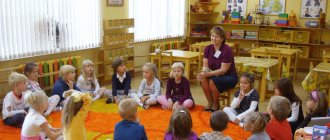Preview:
Project on theatrical activities in the middle group “Theater and us”
“The theater is a magical land in which a child rejoices while playing,
and in the game he learns about the world!”
Childhood is not a small country at all, it is a huge planet where every child has his own talents. It is important to treat children's creativity with care and respect, no matter in what form it appears.
The shortest way to emotionally liberate a child, relieve tension, teach feeling and artistic imagination is through play, fantasy, and writing. It is known that children love to play; they should not be forced to do so. While playing, we communicate with children on “their territory.” By entering the world of play, we can learn a lot ourselves and teach our children. “A game is a huge window through which a life-giving stream of ideas and concepts about the world around us flows into the child’s spiritual world. A game is a spark that ignites the flame of inquisitiveness and curiosity” (V.A. Sukhomlinsky)
And the words spoken by the German psychologist Karl Gross are relevant in this regard: “We play not because we are children, but childhood itself is given to us so that we can play.”
The founder of the Moscow Puppet Theater S.V. Obraztsov once expressed the idea that every child has a natural desire for acting. Theater is always a game, always a fairy tale, a miracle... .
How to transfer a children's game to the stage? How to make a performance out of a game, and a game out of a performance? There is only one way - creating conditions for theatrical activities of children in kindergarten.
Theatrical activity is the most common type of children's creativity. It is close and understandable to the child, deeply. From a very early age, the child strives for creativity. Therefore, it is so important to create an atmosphere of free expression of feelings and thoughts in the children's team, to awaken the imagination of children, and to try to realize their abilities to the maximum.
Relevance. Our society needs a person of such quality who could boldly enter into a modern situation, be able to handle a problem creatively, without prior preparation, and have the courage to try and make mistakes until the right solution is found.
Theatrical games allow solving many pedagogical problems related to the formation of expressiveness of speech, intellectual, communicative, artistic and aesthetic education, the development of musical and creative abilities.
Artistic and aesthetic education occupies one of the leading places in the educational process of a preschool educational institution and is its priority direction. An important task of artistic and aesthetic education is the formation of creative abilities in children. The richest field for solving this problem is theatrical activity.
- insufficient attention of parents and children to the theater;
- Children’s “acting skills” are poorly developed;
- There are not enough theatrical costumes and masks in the group.
- shyness of children, poorly developed artistic imagination.
Novelty. The means and methods of theatrical and play activities aimed at developing the speech apparatus, fantasy and imagination of children of middle preschool age, mastering communication skills, collective creativity, and self-confidence have been systematized.
Due to the relevance of this problem, the goal of the project is to develop the artistic and creative abilities of preschool children through theatrical activities.
1.Create conditions for the development of children’s creative activity.
2. Introduce children to theatrical culture and enrich their theatrical experience.
3.Develop children’s artistic skills in terms of experience and embodiment
images, as well as their performing skills.
4. Create an atmosphere of emotional comfort, mutual understanding and support.
5. To cultivate in the soul of every child a sense of beauty and to instill a love of art, to ardently sympathize and empathize.
The implementation of these tasks requires taking into account the basic principles of organizing a theatrical game.
1. The principle of organizing person-oriented interaction taking into account individual capabilities - accepting and supporting his individuality, interests and needs, developing creative abilities, caring for his emotional well-being.
2. The principle of integration - the content of theatrical games is interconnected with other sections of the program for raising and educating children in kindergarten.
3. The principle of coordination of the teacher’s activities - the activities of specialists are coordinated with the educational activities of the music director.
4. The principle of age targeting - the content of the activity is built in accordance with and taking into account the age of the children.
5. The principle of continuity of interaction with the child in the kindergarten and family settings - parents support forms of work with children and continue them in the family.
Expected result of the project
- Enriched group environment;
- Card index of audio, video materials, presentations;
- Development of interest in fiction and dramatization of works.
- Expansion of vocabulary, development of coherent speech;
- Activation of children's creative abilities;
- Active participation of parents in the life of the group;
Summary of the plot-role-playing game “Going to the Theater”
Role-playing game “Go to the theater”
Goal: to teach children the ability to apply previously acquired knowledge in the game; strengthen children's ideas about the theater; promote a culture of behavior in public places.
Tasks:
• Teach your child to enter an imaginary situation.
• Find out how to set up a play area.
• Develop the ability to listen to an adult, the ability to interact between children, develop thinking, attention, memory, imagination.
• Stimulate speech activity.
• Involve yourself in a game situation, encourage role selection.
• Develop cultural, moral and aesthetic education.
• Introduce children to the world of theater.
Equipment.
A cap and steering wheel for the driver, theater tickets (pre-prepared, toy money in wallets, dresses for the waitresses, costumes for the actors, signs “Theater”, “Box Office”, “Buffet”, cheerful music.
Progress of the game.
Teacher: Guys, today is an unusual day for us. Today we'll go to the theater. Tell me, do you like going to the theater?
(Children's reviews)
Educator: A letter arrived in the mail with an invitation to the theater for the play “Ryaba’s Chicken.”
The teacher reads out the invitation.
Educator: For the performance to take place, who does it need?
Children: actors.
Educator: We assign roles and choose actors.
The teacher, together with the children, distributes roles using the board.
One two three four five.
We can't count our friends
And life without a friend is hard,
Leave the circle early.
The actors go to the dressing room and change clothes.
Educator: The theater is far away, we can’t get there on foot, let’s solve the riddle and find out where we will get there.
What a miracle: a long house!
There are many passengers in it.
Wear rubber shoes
And it runs on gasoline. (Bus)
Teacher: That's right, we'll go by bus. Who will be our driver?
The teacher chooses a driver, puts a cap on him and gives him the steering wheel. The children stand up one after another, placing their hands on their neighbor’s shoulders. They are traveling on a bus to cheerful music.
Educator: Guys, what do we need for the theater?
Children: buy tickets.
Teacher: Who sells theater tickets?
Children: cashier.
Educator: chooses a cashier and is the first to buy a ticket. Children buy tickets for the teacher, go to the classroom, and sit in the seats indicated on the tickets. (The teacher helps the children find their place.)
Educator: Guys, how should you behave in the theater?
Children: do not make noise, do not shout, do not talk, etc.
Educator: what needs to be done to launch the performance?
Children: clap their hands.
The children applaud and the game begins (production of the fairy tale “Ryaba Chicken”).
Educator: Now let's go to the buffet. You can drink tea there.
Two girls are chosen as waitresses to sell tea and sandwiches.
Children go to the buffet, buy food and sit at the tables. They wash the dishes.
Educator: Guys, now it’s time for us to go back to kindergarten.
They choose a driver, and the children and the teacher return to kindergarten to the rhythm of the music.
Educator: Guys, did you like our trip to the theater? What did you like most? What was the name of the show? Which actor did you like best?
(Children's answers) Educator: I also really liked the performance, and all the actors who played for us today were faced with their roles. Next time we will go to another performance.
Project on theatrical activities in the middle group
Irina Gimaeva
Project on theatrical activities in the middle group
Project type : practice-oriented
Age of children: middle group
Project participants : children, teachers, parents
Relevance: “ The theater is a magical world . He gives lessons in beauty, morality and ethics. And the richer they are, the more successful the development of the spiritual world of children is” (B. M. Teplov)
.
The most popular and exciting area in preschool education is theatrical activities . Creative activity and the development of human creative abilities are the main part of the socio-economic and spiritual directions of the modern and social order. Particular importance in children's educational institutions should be given to theatrical activities , all types of children's theater , because they help to form the correct model of behavior in the modern world, improve the general culture of the child, introduce him to spiritual values, introduce him to children's literature, music, fine arts, and the rules of etiquette , rituals, traditions. Improve the skill of embodying certain experiences in the game, encourage the creation of new images, encourage thinking.
Theatrical activities are the most common type of children's creativity. It is close and understandable to the child. Theater activities help develop the child’s interests and abilities; contribute to general development, the manifestation of curiosity, and the desire to learn new things. In theatrical activities, the child liberates himself, conveys his creative ideas, and receives satisfaction from the activity . Theatrical activities help to reveal the child’s personality, his individuality, and creative potential. The child has the opportunity to express his feelings, experiences, emotions, and resolve his internal conflicts.
The implementation of this project will make the life of children interesting and meaningful, filled with vivid impressions, interesting activities, and the joy of creativity.
Problem: inability to convey the emotional character of the characters. Insufficient vocabulary and related speech.
The goal of the project : to consistently introduce children to various types of theater , develop initiative, independence, connected speech, imagination and fantasy.
Project objectives :
-Develop expressive speech in children;
-Arouse in children an interest in theater , a desire to participate in theatrical activities ;
-Promote the development of children's creative activity;
-Development of fine motor skills of the hands.
-Involve parents in making characters based on fairy tales;
-Exhibition of drawings “We are from a fairy tale”
;
theater and joint theatrical activities among children and parents ;
-Photo vernissage “To the puppet theater with the family ”
-Develop a plan for the year;
-Develop scenarios for open events for the year.
-Through a system of various events, basic concepts about children's theatrical activities ;
-Acquisition by children of primary skills in the field of theatrical art ;
-Development of the emotional background and speech of preschoolers, replenishment of the theater corner ;
-Enthusiastic use of the theater center by children in the group in independent activities and good performance in acting for children 4-5 years old.
Stage 1 - preparatory, information and research:
of theater together by the teacher with parents and children ;
-Reading works of fiction (fairy tales, stories)
;
-Development of an entertainment scenario for children.
The second stage is the main one:
Preliminary work: parents and children made puppet theater characters for the fairy tale “Puff”
processing N. Myalika.
-Introducing children to the Belarusian fairy tale “Pykh”
processing N. Myalika.
Consideration of the heroes of the puppet theater .
-Individual work with fairy tale characters.
-Individual work with characters on onomatopoeia of fairy tale heroes.
-Demonstration of the fairy tale “Pykh”
.
Preliminary work: parents and children made carton theater characters for the fairy tale “Turnip”
.
-Reading the Russian folk tale “Turnip”
.
-Examination of the heroes of the carton theater .
-Re-reading the fairy tale.
-Individual work with fairy tale characters.
-Individual work with characters on onomatopoeia of fairy tale heroes.
-Demonstration of the fairy tale “Turnip”
.
Preliminary work: parents and children made puppet theater characters for the fairy tale “Teremok”
.
-Reading the Russian folk tale “Teremok”
.
-Examination of the heroes of the puppet theater .
-Re-reading the fairy tale.
-Individual work with fairy tale characters.
-Individual work with characters on onomatopoeia of fairy tale heroes.
-Demonstration of the fairy tale “Teremok”
.
Preliminary work: parents, together with their children, made characters from the Finger Theater for the fairy tale “Zayushkina’s Hut”
.
-Reading the fairy tale “Zayushkina’s hut”
.
-Examination of the heroes of the Finger Theater .
-Individual work with the characters of the story.
-Individual work with characters on onomatopoeia of the heroes of the story.
-Demonstration of the fairy tale “Zayushkina’s hut”
.
Preliminary work: parents and children created Finger Theater characters for the fairy tale “Wintermovie”
processing I. Sokolova-Mikitova.
-Introducing children to the Russian folk tale “Wintermovie”
processing I. Sokolova-Mikitova.
-Individual work with fairy tale characters.
-Individual work with characters on onomatopoeia of fairy tale heroes.
-Demonstration of the fairy tale “Wintermovie”
.
Preliminary work: parents and children made finger theater characters for the fairy tale “Kolobok”
.
-Reading the Russian folk tale “Kolobok”
.
-Examination of the heroes of the Finger Theater .
-Re-reading the fairy tale.
-Individual work with characters to convey the character’s character.
-Individual work with characters.
-Demonstration of the fairy tale “Kolobok”
.
Preliminary work: parents and children made cardboard theater characters for the fairy tale “The Three Bears”
.
-Reading the fairy tale by L. N. Tolstoy “The Three Bears”
.



